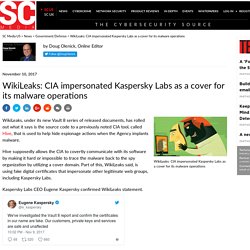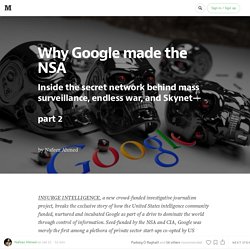

WikiLeaks: CIA impersonated Kaspersky Labs as a cover for its malware operations. WikiLeaks, under its new Vault 8 series of released documents, has rolled out what it says is the source code to a previously noted CIA tool, called Hive, that is used to help hide espionage actions when the Agency implants malware.

Hive supposedly allows the CIA to covertly communicate with its software by making it hard or impossible to trace the malware back to the spy organization by utilizing a cover domain. Part of this, WikiLeaks said, is using fake digital certificates that impersonate other legitimate web groups, including Kaspersky Labs. Kaspersky Labs CEO Eugene Kaspersky confirmed WikiLeaks statement. Legacy Media Silent On Wikileaks’ Publication Of Vault 8. A few days ago, Wikileaks published Vault 8, which includes the source code for Wikileaks’ earlier Vault 7 publication.

Wikileaks made clear that, like Vault 7, Vault 8 does not include ‘zero day’ exploits. Wikileaks‘ press release explains Vault 8’s inclusion source code and development logs of Hive, a “major component of the CIA infrastructure to control its malware.” Despite the importance of Vault 8’s content, legacy press has largely ignored news of its release. Utter media silence surrounding Wikileaks’ latest publication may be somewhat explained by the shadow it casts on claims that Kaspersky Lab was involved in some sort of attempt at Russian interference, as establishment media claimed recently as part of their ongoing Russian hacking narrative. 14 Cutting Edge Tech Firms Funded By The CIA – Collective Evolution. WikiLeaks: CIA Can Hack Cars to Carry Out "Undetectable Assassinations" - Just Like Michael Hastings. Award-winning journalist Michael Hastings garnered international acclaim for coverage of the Iraq War and had established a comfortable career with BuzzFeed, GQ, and Rolling Stone when his life abruptly ended in a fiery one-car crash under such suspicious circumstances, a prominent national security official claimed it was “consistent with a car cyber attack.”

“There is reason to believe that intelligence agencies for major powers,” including the United States, have developed the technology to remotely seize control of a vehicle, former U.S. National Coordinator for Security, Infrastructure Protection, and Counter-terrorism Richard A. Clarke told Huffington Post shortly after Hastings’ death in June 2013. BREAKING: WikiLeaks' Vault 7 Shows How CIA Spies on Your TV, Phone, PC, Mac, and More. Only moments ago, WikiLeaks released what it claims to be the largest ever release of confidential documents on the CIA.

This dump comes on the heels of a preview that the Free Thought Project reported on last month, in which WikiLeaks released documents showing the CIA’s role in interfering with French elections. This dump, however, is the apparent motherlode, which the transparency organization allegedly obtained from the CIA’s Center for Cyber Intelligence in Langley. It involves a massive cache of data ranging from the years 2013-2016. Inside this data, according to WikiLeaks, are the tools the CIA has been using for years to wreak digital havoc on the world. According to the release: SPECIAL: Wikileaks Vault 7 CIA Cyber Dabbling — and False Flag Cyber Attacks Blamed on Russia « Public Intelligence Blog.
Leaked CIA Document: CIA Uses “False Flag” Cyberattacks to Blame Russian Hackers WikiLeaks Press Release on CIA Vault 7 8,761 Items Since 2001 the CIA has gained political and budgetary preeminence over the U.S.

The CIA, NSA and Pokémon Go. With Pokémon Go currently enjoying, what I would call, a wee-bit-o-success, now seems like a good time to talk about a few things people may not know about the world's favorite new smartphone game.

This is not an opinion piece. I am not going to tell you Pokémon Go is bad or that it invades your privacy. “Reality” Edited in Real Time: New Tech Shows Why You Can’t Trust Anything You See on the News. By Melissa Dykes | Activist Post Talk about wag the dog.

I’m not even sure what to write for a description of the video you are about to watch. So-called “reality” can be edited in real-time. It’s the matrix. The project is a joint effort in progress between Stanford, the Max Planck Institute for Informatics, and the University of Erlangen-Nuremberg. Project Blue Beam Mass Psyop: Government Researched Projecting Sky Holograms of God (VIDEO)
By Aaron and Melissa Dykes | ActivistPost.com “Seeing” and “hearing” haven’t been equal to “believing” for a long time.

Related Article: Where Have All the False Flag Crisis Actors Gone? Why Google made the NSA. Mass surveillance is about control.

It’s promulgators may well claim, and even believe, that it is about control for the greater good, a control that is needed to keep a cap on disorder, to be fully vigilant to the next threat. But in a context of rampant political corruption, widening economic inequalities, and escalating resource stress due to climate change and energy volatility, mass surveillance can become a tool of power to merely perpetuate itself, at the public’s expense. A major function of mass surveillance that is often overlooked is that of knowing the adversary to such an extent that they can be manipulated into defeat. The problem is that the adversary is not just terrorists. It’s you and me. The Locations of Global Spy Stations Have Now Been Exposed.
Jon Queally | Common Dreams A new batch of Snowden documents offer an unprecedented look into the close relationship of the surveillance agencies of the so-called “Five Eyes” nations and how a close look at a secretive base in New Zealand reveals new details about a global network of listening stations are operating to fulfill the NSA mantra on communications data which says, “Sniff it all, collect it all, know it all, process it all and exploit it all.”

Reported on Saturday by The Intercept in the U.S. and the Sunday Star-Times in New Zealand, the documents offer a detailed look at the “alien-like” station located in Waihopai Valley and reveals who and what kind of information the station targets, its inner workings, and how its operations link to an international network of spy facilities run by the other so-called “Five Eyes”—comprised of the intelligence agencies of the U.S., U.K., Canada, New Zealand, and Australia.
The leaked documents do not talk about “Waihopai”. Related. The NSA hides surveillance software in hard drives. It's been known for a while that the NSA will intercept and bug equipment to spy on its soon-to-be owners, but the intellgency agency's techniques are apparently more clever than first thought. Security researchers at Kaspersky Lab have discovered apparently state-created spyware buried in the firmware of hard drives from big names like Seagate, Toshiba and Western Digital.
When present, the code lets snoops collect data and map networks that would otherwise be inaccessible -- all they need to retrieve info is for an unwitting user to insert infected storage (such as a CD or USB drive) into an internet-connected PC. Angry Birds and 'leaky' phone apps targeted by NSA and GCHQ for user data. The National Security Agency and its UK counterpart GCHQ have been developing capabilities to take advantage of "leaky" smartphone apps, such as the wildly popular Angry Birds game, that transmit users' private information across the internet, according to top secret documents.
The data pouring onto communication networks from the new generation of iPhone and Android apps ranges from phone model and screen size to personal details such as age, gender and location. Some apps, the documents state, can share users' most sensitive information such as sexual orientation – and one app recorded in the material even sends specific sexual preferences such as whether or not the user may be a swinger. Many smartphone owners will be unaware of the full extent this information is being shared across the internet, and even the most sophisticated would be unlikely to realise that all of it is available for the spy agencies to collect.
Millennial Media did not respond to a request for comment. “This Is An Emergency Action Notification… Your Channel Has Been Force Tuned” Overtakes TV Stations For Thousands of Viewers. (Before It's News) Thousands of viewers in Atlanta, Austin and Dallas had their television service overtaken by the national Emergency Action Notification system today. According to Fox Engineers, the EAN can only be activated by the President of the United States, prompting questions about to how the system was able to force tune regularly scheduled programming when no emergency had been declared.
A statement from AT&T U-verse says the company is trying to figure out how and why the EAN system was activated on their network: “Earlier today U-verse TV customers may have received an Emergency Alert notification. Exclusive: Inside the NSA’s Private Cloud. The National Security Agency (NSA) had a problem familiar to any enterprise IT manager executive: it was running out of space for hundreds of disparate relational databases that contain everything from back-office information to intelligence on foreign interests.
And it needed to consolidate those databases to make it easier for NSA analysts to do their job. The NSA’s initial approach was to scale up capacity. But halfway through the process, the staff realized that simply increasing the scope of the network was not going to work. So, CIO Lonny Anderson convinced General Keith Alexander, who was then Director of the NSA and Commander of U.S.